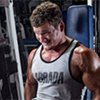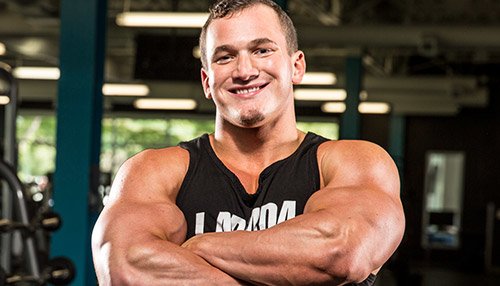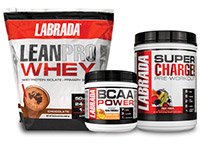
Hunter Labrada's Favorite Exercises For Every Body Part
Looking to add some new moves to your body-part routines—or just get more bang for your buck with your existing exercises? Hunter Labrada has you covered!
Over my last nine years of training, I have tried implementing just about every exercise imaginable into my routines. Some were disasters that ended with tweaked muscles (good mornings should be called bad mornings), while others became fixtures of my go-to rotation of exercises. Many other moves fell in between those extreme outcomes.
Before I tell you what my favorite compound and isolation movements are for each body part, I want to tell you what I've found to be, by far, the most effective technique for lifting any body part. I have made the most progress and had the most pain- and injury-free body over the last two years because I have decreased the weight I use and slightly increased my reps to 12-15 per set. What's more, I have placed paramount effort into lifting with proper form and truly feeling exercises where I should be feeling them—the muscle being trained!
I know that sounds pretty intuitive, but I, like most, had a hard time checking my ego at the door and lightening things up to the point where I could truly target the muscle being trained, instead of just moving the weight. However, extending the time under which my muscles are under tension, by lifting in a slower and more controlled manner, has made all the difference in my workouts. I truly encourage you to apply these techniques to all of the exercises I'm about to talk about!
Now, let's get to my favorites.
Chest
Compound Exercise Slight-Incline Dumbbell Bench Press
My favorite compound chest movement is, by far, a slight-incline dumbbell bench press. I have almost exclusively replaced all flat dumbbell presses with these for a couple reasons. First, placing the bench at a slight incline removes a lot of the stress that being completely flat places on your anterior deltoids and rotator cuffs. It is no secret that flat presses place your shoulder joint at a disadvantageous position. It's crazy how much difference moving the bench up one hole makes!
In addition to removing a lot of the mechanical shortcomings of a truly flat press, being at a slight incline places even more of the stress of the pressing motion where it should be—on your chest. This is especially true if you use an extreme arch in your back when you bench. As a side note, I have no problem with an arch in your back while you bench.
Incline Dumbbell Press with Hunter Labrada
Watch the video - 0:16
In fact, I encourage people to have a big enough one to be able to have their training partner stick their hand under it. This forces you to keep a "big chest" and keep the tension where it should be. It also makes your entire body as rigid and as stable as possible, minimizing risk of injury and allowing maximal exertion on the exercise being performed.
That being said, I am highly opposed to your butt coming off the bench, or your feet coming of the ground—both of which do the exact opposite of what a good arch does. They destabilize your body, open your back and neck up to injury, and take the stress off your chest.
To perform this exercise, you will need an adjustable bench that goes from completely flat, and you will set it one to two holes above the completely flat setting. Play around with it; find what setting works best for you. The goal is to relieve the stress from your shoulders and place the maximal amount of tension on your chest.
Isolation Exercise Cable Fly
Cables are a crucial tool for chest development, in my opinion, and are definitely my favorite apparatus for doing flies. I prefer them over dumbbell flies because, even when performing dumbbell flies correctly, there is still a portion of the exercise where tension begins shifting from your chest to your shoulder joints and triceps. This portion is the top of the rep, whenever the weights are over the center mass of your body.
Also, because of gravity, you are much more likely to have some degree of a pressing motion involved with doing flies with dumbbells, since the resistance is pushing down, and not pulling out like a cable fly does. I also prefer cables over a pec deck or machine fly because most of these machines offer no adjustability when it comes to the angle in which you place the tension on the chest. Especially with a fly, there is no such thing as a one-size-fits-all machine.
Cable Fly with Hunter Labrada
Watch the video - 0:16
With cables, you have the ability to keep constant tension on the chest. In fact, the top portion of the rep is actually the hardest with cables, because you have to force a full contraction with the muscle fully loaded, instead of only a fraction of the weight, as you do with dumbbells. Also, cables pull out instead of down, making it much easier for you to lock a slight angle in your elbow and use a true flying motion void of any pressing component. Finally, since cables allow you to do the move standing or using a bench, you can really dial in the angle to place the maximum amount of tension where you want it.
My personal favorite variation is to set the cables pulleys 4-6 inches below your shoulder joint. While keeping a big chest, bring them from the resting position—which should be slightly below your shoulder joint—to the front of your chin, making for a slightly upward motion track.
Also, have your hands cupped slightly in once you begin the rep—you should feel the pressure from the handles mainly on the part of your palm closest to your pinky finger. Doing so will take away the ability to use your front delts, place even more of the load on your chest, and allow for maximal contraction.
Shoulders
Compound Exercise Dumbbell Shoulder Press
My favorite compound motion for shoulders is the dumbbell shoulder press. However, I feel a lot of people do it wrong, and subsequently don't receive the full benefit of this awesome exercise.
I am a big proponent of performing these on an adjustable bench that supports your head, with the bench set one hole shy of 90 degrees. The are several reasons I prefer this to the bench that is actually made for shoulder pressing, which is a bench with a 90 degree angle and a back pad that stops at the middle of your back.
If the back support stops at the middle of your back, the tendency is for lifters to have a big arch in their back. This gets their upper pecs and anterior deltoids more involved than they should be. Using a bench with a back support that goes past the head fixes this problem.
Dumbbell Shoulder Press with Hunter Labrada
Watch the video - 0:16
Second, when pressing dumbbells—or a barbell, for that matter—seated, the point of pressure that you push from should be your shoulder blades and lower traps, not the back of your head, like I see a lot of people do. By keeping the point of pressure in the correct spot, and your head slightly off the bench, you are positioning your body in a way that is optimal to use mainly your medial delts, which should be the area of focus when performing this exercise.
For the best contraction, push your back into the bench as hard as possible. Doing so will provide the most stable pressing platform and allow for the hardest contraction, while taking out the ability to overuse your upper chest and anterior deltoids.
Isolation Exercise Seated Dumbbell Lateral Raise
Doing your side laterals seated offers several advantages over doing them standing. First, your ability to cheat the weight up using your legs is gone. Second, you are able to get a better range of motion, and a more natural track of motion, than when standing. That's because the weights can go slightly underneath the bench you're sitting on, instead of having to go in front of you the way they do when you're standing.
Seated Dumbbell Side Raise with Hunter Labrada
Watch the video - 0:16
Finally, I find it easier to keep the back at the proper angle—that is, never higher than 90 degrees—when performing side laterals while seated. Doing them in this manner will keep the stress where it should be, on the medial delts.
Back
Compound Exercise Low Cable Row
This movement has been a staple of a good back routine since Arnold's heyday, and for good reason! I chose this movement because it allows you to get a good stretch and force a hard contraction, all while keeping a lot of pressure off your lower back.
I do this exercise almost exclusively with a narrow neutral-grip handle. This handle allows me to really let the lats stretch at the resting point of the rep, and I get a great contraction in my lower lats when I bring the handle into my midsection.
Seated Cable Row with Hunter Labrada
Watch the video - 0:16
When performing this movement, there are two big things you want to keep in mind when it comes to form. First, from the moment you start to row the weight, keep a big chest (shoulders retracted and squeezed). This will make your back, rather than your biceps, move most of the weight. Second, concentrate on moving the weight by keeping your elbows close to your body and driving them back, so that you're pulling the handle into your belly button and waist.
Make sure not to "chicken wing" your elbows out. If you do, you'll hit higher up on your back, which is not good for your shoulders. If you are going to use the narrow neutral-grip handle like I recommend, try to rip the handle apart toward the end of the rep. Yes, you heard me right. Obviously, you won't rip it apart, but intensely pulling outward at the very end of the rep will really force the hardest contraction possible, and has made a big difference for me.
Do not confuse that with me telling you to "chicken wing" your elbows out. I already explained why that is a bad thing to do.
Isolation Exercise Straight-Arm Push-down
If your back is a lagging behind the rest of your physique, start doing straight-arm push-downs. This is by far one of my favorite exercises, and I've kicked off every back workout of mine for the last two years with them. I feel that they have been the exercise most responsible for the progress I've seen in my back in recent years.
When performing this exercise, there are a couple things that you want to keep in mind. First, use a handle that angles your hands toward a neutral position, as this will provide the most natural track of motion for your body. Start in a slight bent-at-the-waist position, with a good stretch in your lats. (You'll feel it when you're doing it right, trust me.) As you bring the bar down to your waist, concentrate on keeping your chest out and driving your elbows back.
Maintain a slight bend in your elbow, and do not allow it to change throughout the rep. Try to make all the motion occur at the shoulder joint! As you bring the weight down, go from the slightly bent-at-the-waist position to an almost-standing-straight-up one. This will maximize the contraction.
Quads
Compound Exercise Barbell Squat
You'd be hard-pressed to find a better exercise for overall leg development than the barbell squat. This exercise has been a pillar of every leg routine I've had since I started playing football when I was 14 years old, and it remains so to this day.
Performed properly, barbell squats will place an enormous strain on your quads, as well as your hamstrings and calves. While there are a lot of really good resources out there to explore on to best perform a squat, I'll tell you how I prefer to do them, and you can take it for what it is: my personal opinion.
When I squat, I prefer to squat with the bar pretty low on my back—more of a powerlifting style. I feel more stable doing them this way, and am able to stay on my heels throughout the whole rep, so much so that I can wiggle my toes when in the bottom position of the squat.
Barbell Back Squat with Hunter Labrada
Watch the video - 0:18
While on the subject of being in the hole, I am a huge proponent of squatting at least to parallel. Actually, I believe it is optimal to go just past it, to where your hip joint is 1-2 inches below your knee. Any lower than that, and I believe you're placing more of a strain on your joints and connective tissues than you're helping your muscles. As far as foot placement goes, I've always been a fan of going slightly wider than shoulder width. I'm a toes-angled-slightly-outward kind of guy, as this is the most natural track of motion for my body.
I don't have much else to say about squatting that hasn't been said by someone else, other than, if you aren't currently doing them, you should be! Barring any medical excuse, that is. But to be honest, most people who have lower-back problems from squatting just use subpar form. They aren't willing to lighten the weight up or spend the time refining the form to where they are doing the exercise correctly.
In no way am I taking a shot at those who genuinely do have spinal issues. But if you are constantly spraining your erectors or connective tissues when squatting, that is a form or too-much-weight issue—not an issue of your body not being right for squatting.
Isolation Exercise Leg Extension
Nothing burns quite like a set of high-rep leg extensions taken all the way to failure with good form. I am a firm believer that sets done in the aforementioned way are one of the main reasons I've been able to develop my legs like I have. I regularly use leg extensions either as a warm-up or finisher for my quad workouts.
Leg Extensionswith Hunter Labrada
Watch the video - 0:19
While many people think of leg extensions as an exercise with performance variables, I beg to differ. A ton of variables go into this exercise, and ignoring one or all of them can place a lot of undue stress on your knee joint and ligaments. I decided that it would be easiest to explain proper form by giving you a checklist:
- Adjust the back pad set so that when you sit down and firmly pull yourself into the seat, your knee lines up with the axis of the center of the machine's pulley. This instruction will probably be on the machine itself in the form of a red target or yellow highlighted area on the part of the pulley I am talking about.
- Set the pad so it goes across the lower portion of your shin, 2-3 inches above the ankle joint, when you're at the very bottom of the rep. Make sure your butt is firmly pulled into the seat.
- At the start of the set, dorsal flex your foot, and hold this position for the entire set. In addition to maintaining dorsal flexion, keep your toes pointed straight up for the whole rep. Doing so will prevent going too far down—if you go too far down, you'll take the stress off your quads and place it on your knee joint and ligaments.
- Raise the weight to just shy of completely locking your knee out, and then return to the starting position. Only go as far as your body allows you to while keeping good form.
Tip Put your fist, a softball, or something of around that size in between your knees, and lightly squeeze it between your knees for the whole set. Doing so will prevent you from going too low into the resting position and will increase the tension placed on your quads.
My favorite isolation exercise is one that has gotten a bad rap in recent years. Once again, it isn't so much the exercise as it is people's form or inability to check their egos that has caused this reputation.
If you follow the above checklist, and use a weight that you can perform at least 10 perfect reps with, you will be in very good territory when it comes to preventing wear and tear and pain on your knees.
Hamstrings
Compound Exercise Stiff-Legged Dumbbell Deadlift
By far, my favorite compound exercise for hamstrings is stiff-legged dumbbell deadlifts. I prefer doing them with dumbbells rather than a bar because you can pull your hips through a lot farther without a bar in the way. This allows for a much more intense contraction.
Stiff-Legged Dumbbell Deadlift with Hunter Labrada
Watch the video - 0:18
When performing this exercise, only go as far down into the stretch position as possible while keeping your back completely flat and your spine straight. The motion should all happen at the hips.
Keep the dumbbells in front of you from the starting position, all the way down to fully stretched and until you get them to your knees. Once you get the dumbbells to your knees, allow them to move to the sides of your legs so you can really pull your hips through and maximize the contraction.
Isolation Exercise Lying Hamstring Curl
This is by far my favorite isolation movement for hamstrings. The load you are able to place on the muscle, and the contraction you are able to get, cannot be replicated by any other exercise, in my opinion.
To maximize the benefits of this exercise, take heed of a few form pointers. The first is to keep your butt down! Too many people allow their hips to come way off the bench when performing this movement. This gets the lower back and glutes involved—and takes the strain off the hamstrings. Try to drive your hips into the bench as you initiate the curl. Doing so ensures you are isolating the hamstrings as much as possible.
Lying Hamstring Curls with Hunter Labrada
Watch the video - 0:18
Doing this exercise with proper form can be a humbling experience, so be ready to significantly lighten the weight if you haven't tried performing the exercise like this before. Also, don't let the weight hyperextend your knees at the bottom of the rep; doing so will take the tension off your hamstrings and place it on your tendons and knee joints.
I personally aim to lower the weight until my legs have barely any angle left in them, but there's a lot of tension felt throughout my hamstrings.



